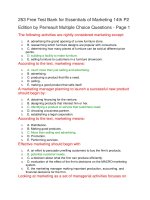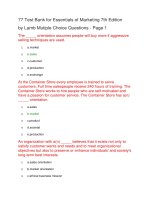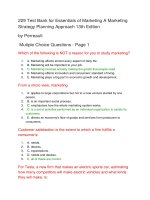Essentials of services marketing 2nd
Bạn đang xem bản rút gọn của tài liệu. Xem và tải ngay bản đầy đủ của tài liệu tại đây (8.24 MB, 290 trang )
Essentials of Services Marketing,
2nd Edition
Chapter One – Introduction
to Services Marketing
Chapter 1 Outline
1.1
1.2
1.3
1.4
1.5
1.6
1.7
2
Why study services?
Powerful forces are transforming service markets
What are services?
Four broad categories of services
Challenges posed by services
The 7 Ps of services marketing
Framework for effective services marketing strategies
© Pearson Education South Asia Pte Ltd 2013. All rights reserved
1.1
Why study services?
3
© Pearson Education South Asia Pte Ltd 2013. All rights reserved
1.1 Why study services?
•
•
Services dominate most economies and are growing rapidly:
–
Services account for more than 60% of GDP worldwide (why?)
–
Almost all economies have a substantial service sector
–
Most new employment is provided by services
–
Strongest growth area for marketing
Understanding services offers you a personal competitive advantage
(How?)
4
© Pearson Education South Asia Pte Ltd 2013. All rights reserved
1.1 Why study services?
Contribution of Services Industries to Global GDP
5
© Pearson Education South Asia Pte Ltd 2013. All rights reserved
1.1 Why study services? (Find your home country)
Estimated Size of Service Sector in Selected Countries
6
© Pearson Education South Asia Pte Ltd 2013. All rights reserved
1.2
Powerful Forces Are Transforming Service Markets
7
© Pearson Education South Asia Pte Ltd 2013. All rights reserved
1.2 Powerful Forces Are Transforming Service Markets
Forces Transforming the Service Economy (1)
Social
Changes
Business
Trends
Advances in
IT
Government
Policies
Globalization
● Changes in regulations
● Privatization
● New rules to protect customers,
employees, and the environment
● New agreement on trade in services
8
© Pearson Education South Asia Pte Ltd 2013. All rights reserved
1.2 Powerful Forces Are Transforming Service Markets
Forces Transforming the Service Economy (2)
Social
Changes
Business
Trends
Advances in
IT
Government
Policies
Globalization
● Rising consumer expectations
● Greater affluence
● Personal Outsourcing
● Increased desire for buying experiences vs.
things
● Rising consumer ownership of high tech
equipment
● Easier access to more information
● Migration
● Growing but aging population
9
© Pearson Education South Asia Pte Ltd 2013. All rights reserved
1.2 Powerful Forces Are Transforming Service Markets
Forces Transforming the Service Economy (3)
Social
Changes
Business
Trends
Advances in
IT
Government
Policies
Globalization
● Push to increase shareholder value
● Emphasis on productivity and cost savings
● Manufacturers add value through service and
sell services
● More strategic alliances
● Focus on quality and customer satisfaction
● Growth of franchising
● Marketing emphasis by nonprofits
10 © Pearson Education South Asia Pte Ltd 2013. All rights reserved
1.2 Powerful Forces Are Transforming Service Markets
Forces Transforming the Service Economy (4)
Social
Changes
Business
Trends
Advances in
IT
Government
Policies
Globalization
● Growth of Internet
● Greater bandwidth
● Compact mobile equipment
● Wireless networking
● Faster, more powerful software
● Digitization of text, graphics, audio, video
11 © Pearson Education South Asia Pte Ltd 2013. All rights reserved
1.2 Powerful Forces Are Transforming Service Markets
Forces Transforming the Service Economy (5)
Social
Changes
Business
Trends
Advances in
IT
Government
Policies
Globalization
● More companies operating on transnational
basis
● Increased international travel
● International mergers and alliances
● “Offshoring” of customer service
● Foreign competitors invade domestic markets
12 © Pearson Education South Asia Pte Ltd 2013. All rights reserved
1.3
What are services?
13 © Pearson Education South Asia Pte Ltd 2013. All rights reserved
1.3 What are services?
Definition of Services
•
•
Services
–
are economic activities offered by one party to another
–
most commonly employ time-based performances to bring about
desired results
In exchange for their money, time, and effort, service customers
expect to obtain value from
–
access to goods, labor, facilities, environments, professional
skills, networks, and systems;
–
normally do not take ownership of any of the physical elements
involved.
14 © Pearson Education South Asia Pte Ltd 2013. All rights reserved
1.4
Four broad categories of services
15 © Pearson Education South Asia Pte Ltd 2013. All rights reserved
1.4 Four broad categories of services – which of
these do you use regularly?
16 © Pearson Education South Asia Pte Ltd 2013. All rights reserved
1.5
Challenges posed by services
17 © Pearson Education South Asia Pte Ltd 2013. All rights reserved
1.5 Challenges posed by services
Differences, Implications, and Marketing-Related
Tasks (1) (Table 1.2)
Difference
Implications
Most service products
cannot be inventoried
Customers turned away
or capacity not used
Intangible elements
usually dominate
value creation
Harder to evaluate
service & distinguish
from competitors
Services are often
difficult to visualize &
understand
Greater risk &
uncertainty perceived
Customers may be
involved in coProduction
Interaction between
customer & provider;
but poor task execution
could affect satisfaction
18 © Pearson Education South Asia Pte Ltd 2013. All rights reserved
Marketing-Related Tasks
Use pricing, promotion,
reservations to smooth
demand; work with ops to
manage capacity
Emphasize physical clues,
employ metaphors and vivid
images in advertising
Educate customers on
making good choices; offer
guarantees
Develop user-friendly
equipment, facilities &
systems; train customers,
provide good support
1.5 Challenges posed by services
Differences, Implications, and Marketing-Related
Tasks (2) (Table 1.2)
Difference
Implications
People may be part of
service experience
Behavior of service
personnel & customers
can affect satisfaction
Operational inputs and
outputs tend to vary
more widely
Hard to maintain quality,
consistency, reliability
Difficult to shield
customers from failures
Marketing-Related Tasks
Recruit, train employees to
reinforce service concept
Shape customer behavior
Redesign for simplicity and
failure proofing
Institute good service
recovery procedures
Time factor often
assumes great
importance
Time is money;
customers want service
at convenient times
Find ways to compete on
speed of delivery; offer
extended hours
Distribution may take
place through
nonphysical channels
Electronic channels or
voice telecommunications
Create user-friendly,
secure websites and free
access by telephone
19 © Pearson Education South Asia Pte Ltd 2013. All rights reserved
1.5 Challenges posed by services
Added by Physical, Intangible Elements Helps
Distinguish Goods (Products) and Services (Fig 1.14)
20 © Pearson Education South Asia Pte Ltd 2013. All rights reserved
1.6
The 7 Ps of services marketing
21 © Pearson Education South Asia Pte Ltd 2013. All rights reserved
1.6 The 7 Ps of services marketing
•
Product elements (Chapter 4)
•
Place and time (Chapter 5)
•
Price and other user outlays (Chapter 6)
•
Promotion and education (Chapter 7)
•
Process (Chapter 8)
•
Physical environment (Chapter 10)
•
People (Chapter 11)
Let’s watch the Wahoo’s Fish Taco videos with these 7ps in
mind. Take notes on each of these factors as you watch the
videos.
22 © Pearson Education South Asia Pte Ltd 2013. All rights reserved
1.7
Framework for effective services marketing
strategies
23 © Pearson Education South Asia Pte Ltd 2013. All rights reserved
1.7 Framework for effective services marketing
strategies
Overview
24 © Pearson Education South Asia Pte Ltd 2013. All rights reserved
Essentials of Services Marketing,
2nd Edition
Chapter Two – Consumer
Behavior in a Services
Context









